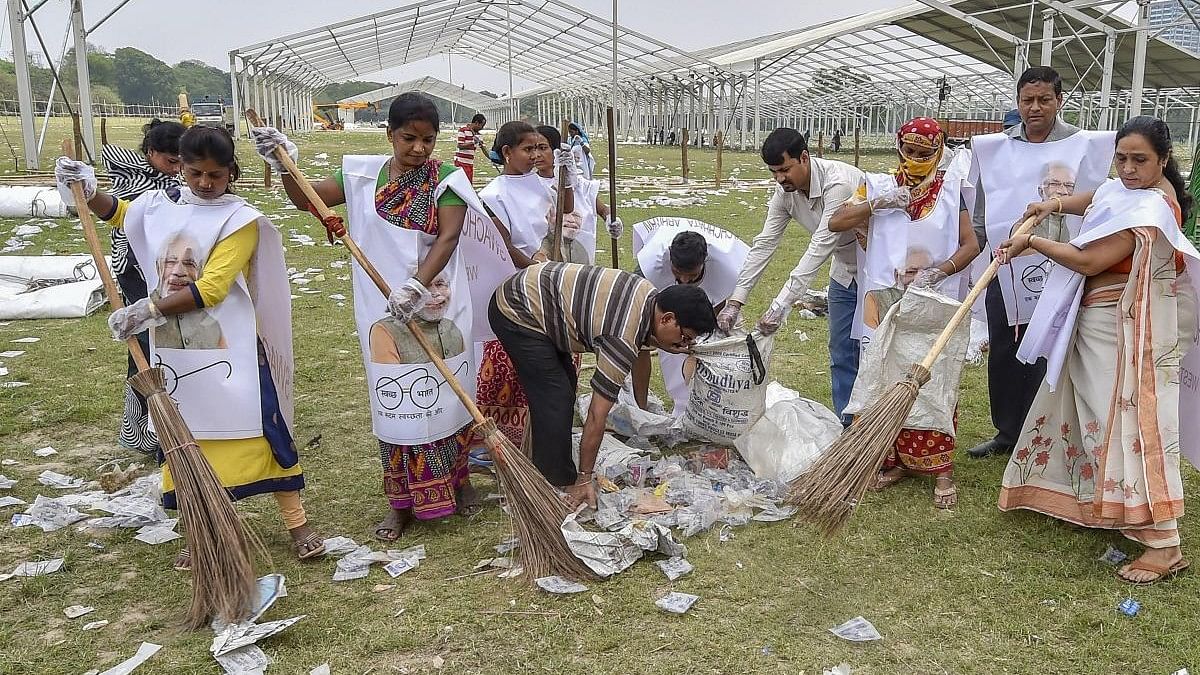
Representative photo for Swachh Bharat Mission
Credit: PTI Photo
As we mark a decade since the launch of the Swachh Bharat Mission (SBM), it is clear that the initiative has positively altered India’s sanitation landscape. By achieving significant progress in eliminating open defecation and enhancing solid waste management, SBM has established itself as one of India’s most transformative public health campaigns. However, it is crucial to shed light on a critical issue – the occupational health and safety (OHS) of sanitation workers who are the backbone of these achievements.
Sanitation workers play a pivotal role in maintaining hygiene standards by managing wastewater and solid waste. Due to the nature of their work, they are exposed to multiple occupational hazards, making their working environment inherently dangerous. Contact with human waste exposes them to pathogens, causing diseases like Hepatitis, tetanus, and cholera. Handling disinfectants and other chemicals can lead to skin and respiratory issues. Poisonous gases like hydrogen sulphide, commonly found in septic tanks, pose risks of asphyxiation and even death. Physical injuries from cuts, slips, and electrocution are also frequent.
Inappropriate tools and the lack of ergonomic equipment contribute to musculoskeletal disorders and repetitive trauma. The profession’s social stigma often leads to psychological issues like anxiety and depression. Moreover, substance abuse, often a coping mechanism for the stress of this precarious work, exacerbates health complications. Research from India and abroad highlights the high morbidity rates among sanitation workers. A 2005 study reported that the average life expectancy of sewer cleaners is only 40–45 years, compared to the national average of 70 years.
Recent initiatives such as the Safai Mitra Suraksha Challenge and Swachh Survekshan have been instrumental in highlighting sanitation workers’ contributions. States like Odisha and Tamil Nadu have also launched welfare schemes specifically for core sanitation workers.
The Prohibition of Employment as Manual Scavengers and Their Rehabilitation Act, 2013, imposes a complete ban on manual waste handling. In 2021, the Ministry of Housing and Urban Affairs (MoHUA) and the Ministry of Social Justice and Empowerment (MoSJ&E) introduced the NAMASTE (National Action for Mechanised Sanitation Ecosystem) scheme to promote mechanised sanitation, eliminate manual scavenging, and improve working conditions. Health insurance benefits under Ayushman Bharat – Pradhan Mantri Jan Arogya Yojana (AB-PMJAY) have also been extended to sanitation workers through the NAMASTE scheme.
Despite these efforts, fatalities during septic tank cleaning and sewer unclogging remain alarmingly high. The National Commission for Safai Karamcharis (NCSK) reports 1,275 sanitation worker deaths across India from 1993 to August 31, 2024, indicating serious safety lapses. In response, the Government of India issued an advisory in 2019 urging states to establish Emergency Response Sanitation Units (ERSUs) in cities. The goal is to regulate human entry into sewers and septic tanks by developing a professional, well-trained, and adequately equipped workforce. However, as of March 2024, only 28 of 732 surveyed sewer and septic tank workers were found to be covered by these units, showing a need for better implementation.
Sanitation work is inherently risky, with liquid waste management posing greater threats compared to solid waste. Deaths are often reported among septic tank and sewer cleaners, making NAMASTE’s focus on these workers crucial. Globally, the Hierarchy of Controls framework is used to identify and rank safety measures, from elimination to the least effective – personal protective equipment (PPE). NAMASTE’s components align well with this framework, ensuring robust safety measures when implemented effectively. However,
a more comprehensive approach is needed to address the occupational health needs of all sanitation workers, including those in solid waste management who face chronic respiratory, dermatological, and other health issues.
A holistic approach to OHS
While India has had an OHS policy since 2009, recognising sanitation work as a hazardous occupation under the Occupational Safety, Health, and Working Conditions Code (OSH Code 2020) could transform safety standards and enforcement. There is limited data on sanitation workers’ health and morbidity patterns. Although many Urban Local Bodies conduct health checkups, data is not systematically captured. A large-scale epidemiological study is needed to establish health baselines and track the health outcomes of sanitation workers.
Periodic health screenings are essential preventive measures. Screening protocols, based on the findings of comprehensive epidemiological studies, should be institutionalised to improve the effectiveness of health checks.
SBM has successfully spurred a nationwide movement towards improved sanitation. However, it is time to extend its mandate to safeguard the health and wellbeing of those who sustain our cities and villages. For the mission to be truly ‘Swachh’ in spirit, it must prioritise the safety, dignity, and empowerment of every sanitation worker.
(The writers are development professionals specialising in water, sanitation, and hygiene)